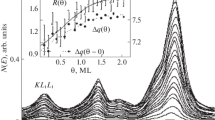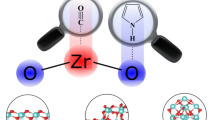Conclusions
-
1.
A study has been made of the modification of the rutile surface by adsorption of butylamine (BA)from the vapor phase, and octadecylamine (ODA) from solution. The coordinationally saturated titanium ions serve as strong centers for the adsorption of the BA and ODA amino groups. A 2∶1 ratio is established between the chemically bound and the physically adsorbed BA molecules on the rutile surface.
-
2.
The texture of the adsorbed amine layer and its variation with the length of the hydrocarbon chain and the conditions of modification were established through study of the adsorption of benzene, methanol, and water vapor on the modified surface. Supplementary methoxylation of the BA-modified TiO2 surface results in a system whose adsorptional properties are identical with those observed in ODA-modified rutile.
-
3.
Water has no effect on the strength of surface bonding in adsorbed amine-TiO2 systems, the situation here being different from that met in the adsorbed alcohol-TiO2 systems. Water does not displace or reorganize the modifying BA or ODA surface layer.
Similar content being viewed by others
Literature cited
S. N. Tolstaya, S. S. Mikhailova, A. B. Taubman, and A. A. Uvarov, Paint and Varnish Materials and Their Applications [in Russian], Vol. 8 (1967).
S. S. Mikhailova, Dissertation, Moscow (1967).
S. N. Tolstaya and S. A. Shabanova, Application of Surface-Active Substances in the Paint and Varnish Industry [in Russian], Khimiya, Moscow (1976).
A. V. Kiselev and A. V. Uvarov, Surf. Sci.,6, 399 (1967).
M. Hermann and H. P. Boehm, Z. Anorg. Allgem. Chem.,73, 368 (1969).
M. Primet, P. Pichat, and M. V. Mathien, J. Phys. Chem.,75, 1221 (1971).
L. Dintenfass, Kolloidn. Z.,155, 121 (1957).
A. A. Isirikyan, S. S. Mikhailova, S. N. Tolstaya, and A. B. Tabuman, Izv. Akad. Nauk SSSR, Ser. Khim., 1252 (1975).
A. A. Isirikyan, S. S. Mikhailova, I. A. Polunina, S. N. Tolstaya, and A. B. Taubman, Kolloidn. Zh.,40, 349 (1978).
A. A. Isirikyan, A. V. Kiselev, and E. V. Ushakova, Kolloidn. Zh.,25, 125 (1963).
Author information
Authors and Affiliations
Additional information
Translated from Izvestiya Akademii Nauk SSSR, Seriya Khimicheskaya, No. 11, pp. 2452–2456, November, 1981.
Rights and permissions
About this article
Cite this article
Isirikyan, A.A., Mikhailova, S.S., Polunina, I.A. et al. Modification of the titanium dioxide surface by aliphatic amines and the structure of the adsorbed layer. Russ Chem Bull 30, 2023–2026 (1981). https://doi.org/10.1007/BF01094621
Received:
Issue Date:
DOI: https://doi.org/10.1007/BF01094621




